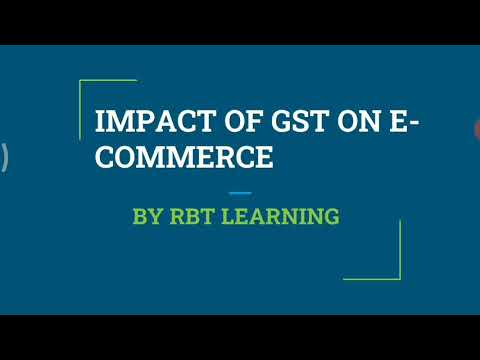Key Takeaways
- GST has unified the tax regime, simplifying compliance and reducing the complexities associated with multiple state taxes.
- Mandatory GST registration for all e-commerce operators ensures wider tax compliance but increases the compliance burden, especially for small players.
- The introduction of Tax Collection at Source (TCS) helps in the pre-collection of taxes but adds to the operational complexities of e-commerce businesses.
- Improved logistics and supply chain efficiency under GST have reduced costs and enhanced service delivery across state lines.
- Continuous adaptation and technology integration are crucial for navigating the ongoing challenges posed by the multi-tiered GST system.
The Goods and Services Tax (GST) was introduced in India in 2017 as a revolutionary tax reform aiming to replace multiple indirect taxes with a single, unified tax system. This change has significant implications for all sectors, including the flourishing e-commerce industry. This article explores how GST affects e-commerce in India, discussing its advantages, challenges, and impact on different business models.
GST and International Taxation of E-commerce

GST adheres to the destination principle, which means that taxes are applied based on where goods or services are consumed rather than where they are sold. This approach aligns with global standards but complicates compliance for e-commerce operators who deal across borders. E-commerce transactions that cross international boundaries involve additional layers of tax regulation. For example, inter-state supply transactions attract an integrated GST (IGST), which combines both central and state taxes.
- Compliance Challenges
E-commerce platforms face significant compliance burdens under GST, including multiple registration requirements and complex GST return filing processes. This increases operational costs and administrative workload, particularly for e-commerce operators without physical operations in different states. The tax collection at source (TCS) and classification of products and services also add layers of complexity and potential tax liability, affecting the working capital of e-commerce operators.
- Equalisation Levy
Introduced alongside GST, the Equalisation Levy aims to tax digital transactions and is particularly focused on international e-commerce. It targets non-resident e-commerce operators providing digital advertising services and has been expanded to include various online services and goods. This levy is imposed at 2% on gross payments made to foreign e-commerce operators, which adds another layer of tax that businesses need to manage. However, if a business has a permanent establishment in India or the transaction is already covered under GST, the levy does not apply.
- Significant Economic Presence (SEP)
SEP is another crucial aspect of India’s approach to international e-commerce taxation. Introduced to capture tax revenues from foreign entities significantly engaged in the Indian digital economy, SEP considers the revenue and user interaction thresholds to determine tax liability, even if non-resident does not have a physical presence in India.
- Recommendations for Simplification
To address these complexities, there have been calls for reforms, such as simplified registration processes, clearer classification principles, and better integration of payment systems to streamline GST compliance for e-commerce. Such reforms are crucial for maintaining the growth trajectory of the e-commerce sector in India by making the tax system more manageable for all parties involved.
The interplay between GST and international tax regulations continues to evolve, highlighting the need for ongoing adjustments to ensure that the system supports the dynamic nature of e-commerce while aligning with global complete taxation practices.
Global Standards and GST Alignment
The alignment of India’s Goods and Services Tax (GST) with global indirect tax standards, particularly those set out by the OECD’s International VAT/GST Guidelines, underscores a significant shift towards a more streamlined and harmonized approach in handling the complexities of the digital economy and cross-border e-commerce.
- Global Trends in GST/VAT Implementation
The global trend in indirect taxation is moving towards the digitalization of tax compliance and the increase of VAT/GST rates as countries seek more stable and transparent revenue sources. This shift is particularly crucial in the digital economy, where traditional models of taxation based on physical presence are increasingly inadequate.
Digital compliance systems such as real-time reporting and electronic invoicing are becoming the norm, which allows for more efficient tax collection and compliance monitoring by tax authorities.
OECD’s Role and Guidelines:
The OECD plays a pivotal role in shaping these standards through its International VAT/GST Guidelines. These guidelines advocate for consistency in tax treatments across countries, emphasizing the destination principle, which taxes goods and services based on where they are consumed rather than where they are produced. This principle is crucial for preventing tax evasion and ensuring fair competition among businesses by leveling the playing field, irrespective of physical presence.
India’s Adoption of Global Standards: India’s GST system incorporates many of these international principles. It is designed to reduce complexity and remove the cascading effect of the previous tax system.
By aligning with international standards, India aims to improve the ease of doing business and attract more foreign investment. The GST also adapts to the unique challenges of taxing the digital economy, addressing issues like digital payments and cross-border services
These global standards and India’s alignment with them signify an ongoing evolution in the approach to indirect taxation, reflecting broader economic and technological trends that impact how businesses operate worldwide. As digital transactions continue to grow, these taxation frameworks are likely to continue evolving to meet new challenges and opportunities in the global economy.
Types Of Business Models In The E-Commerce Industry
The e-commerce industry features a diverse range of business models, each catering to different market needs and operational strategies. Understanding these models is crucial for navigating service tax implications and compliance requirements effectively.

Main E-commerce Business Models
- Business-to-consumer (B2C): This is the most common model, where businesses sell directly to the consumer. It includes both online stores and brick-and-mortar establishments.
- Business to Business (B2B): Here, transactions occur between two businesses, such as a manufacturer selling to a retailer. This model often involves higher order values and bulk transactions.
- Consumer-to-Consumer (C2C): Platforms like eBay, where individuals can sell goods and services to each other, exemplify this model.
- Consumer-to-Business (C2B): In this reverse model, individuals offer products or services to businesses, as seen in stock photo services, where photographers sell their images to companies.
- Business-to-Administration (B2A): This model involves transactions between businesses and public administrations or government agencies, often characterized by long sales cycles and high compliance requirements due to extensive regulations.
- Consumer-to-Administration (C2A): This model covers transactions from individuals to government bodies, such as tax payments or health service fees.
Service Tax Implications and Compliance
Each business model faces unique challenges in terms of service tax and compliance:
- B2C and C2B models are typically more straightforward but require careful management of sales taxes and compliance with local and international tax laws, especially when selling across borders.
- B2B transactions might involve more complex invoicing and tax documentation requirements due to the larger scale and volume of transactions.
- C2C sales often rely on the platform provider to manage tax collection and remittance, which can simplify individual seller responsibilities but also requires understanding the platform’s policies.
- B2A and C2A require navigating government procurement processes and may involve specific tax exemptions or obligations, such as VAT or GST applicability and compliance with sector-specific regulations.
For e-commerce businesses, choosing the right model involves assessing market needs, operational capabilities, and tax compliance obligations. As digital commerce evolves, staying informed about tax regulations and leveraging technology for compliance, like automated tax solutions, becomes increasingly important to ensure business efficiency and regulatory adherence.
Role of GST in India’s Taxation System
Filing GST returns in India involves a systematic procedure that starts with registering for GST. Once registered, you must maintain accurate transaction records, calculate your GST liability, and then file your returns online through the GST portal. GST returns vary based on the type of taxpayer and the nature of transactions. For instance, the common monthly returns for regular taxpayers include GSTR-1 (outward supplies) and GSTR-3B (summary of outward supplies and input tax credit).
The process is significantly streamlined through automation. Several platforms offer solutions to integrate invoice data directly, enabling easier, faster, and more accurate filing. These platforms help manage all your GST return forms in one place, provide smart invoice reconciliation, and support efficient input tax credit claims.
Moreover, to mitigate any risks associated with non-compliance, these platforms also keep track of changing deadlines and regulations, ensuring that your business remains compliant with the GST laws. This comprehensive approach not only simplifies the filing process but also reduces the likelihood of errors and penalties associated with late or incorrect filings.
For businesses engaged in e-commerce or those with higher compliance needs, specialized forms such as GSTR-8 (for e-commerce operators) are also required. Each type of file return has specific deadlines and guidelines that must be strictly followed to maintain compliance and avoid penalties.
The use of automated tools and GST compliance software has become increasingly valuable for businesses, providing a more streamlined, efficient approach to managing GST filings and ensuring compliance with the tax regulations in India.
Challenges in GST Implementation
Despite its benefits, the implementation of GST in e-commerce has not been without challenges.
- Complex Tax Structure: GST features multiple tax rates and special categories, causing confusion and complicating compliance for businesses.
- Frequent Regulatory Changes: Constant updates to GST laws and procedures add to the complexity, requiring businesses to stay continually informed to remain compliant.
- Technological Glitches: Problems with the GST technological infrastructure, such as portal outages and slow processing times, hinder the filing process and affect compliance accuracy.
- Input Tax Credit (ITC) Issues: The system for claiming ITC is highly dependent on suppliers’ compliance. Non-compliance by suppliers can lead to ITC denials for buyers, causing financial strain.
- High Compliance Costs: The detailed and often cumbersome procedures for filing returns lead to increased operational costs, particularly affecting SMEs.
- Implementation of New Systems: While new systems and forms like GST ANX-1 and ANX-2 are being introduced to simplify the filing process, the transition has been challenging and requires businesses to adapt to new workflows.
- Legal and procedural uncertainties: There are ongoing legal challenges and uncertainties, especially regarding the conditions under which ITC is granted or denied, which complicate the compliance environment further.
- Need for Better Infrastructure: There is a critical need for improved IT support and infrastructure to handle the demands of GST filing and to ensure a smoother compliance process for all stakeholders.
Taxation in the E-Commerce Sector

The e-commerce sector is subject to specific GST rates depending on the nature of goods and services sold. This section would detail the applicable GST rates and the process of tax collection at source (TCS), a mechanism introduced to improve tax compliance by e-commerce operators.
- Uniform Tax Structure: GST sought to streamline the tax landscape for e-commerce by eliminating the multiple indirect taxes that varied from state to state. This change was intended to reduce compliance complexity and facilitate easier interstate commerce.
- Compliance and Tax Collection: E-commerce platforms are now required to collect tax at the source (TCS). This means that a percentage of the transaction value is collected during sales, which must be remitted to the government. This system ensures efficient tax collection but has also increased the compliance burden for e-commerce operators.
- Input Tax Credit (ITC) Mechanism: GST allows e-commerce sellers to claim credits for the tax paid on inputs, which can be used to offset future tax liabilities. While this mechanism helps in reducing the overall tax burden, navigating the ITC process can be complex and requires maintaining meticulous transaction records.
- Challenges with Implementation: The shift to a uniform GST has been challenging for many businesses, especially smaller players who face increased costs due to new compliance requirements. Issues like reconciling input tax credits with actual tax payments and managing returns across different states add to the operational challenges.
- Implications of the digital service tax: India has implemented a digital service tax on non-residents’ use of e-commerce services for cross-border transactions. This tax is intended to level the playing field between foreign and domestic e-commerce operators.
Advantages and Disadvantages of GST in the E-commerce Sector
| Advantages | Disadvantages |
|---|---|
| Unified Tax System | Increased Compliance Costs |
| Simplifies tax compliance by replacing multiple indirect taxes with a single tax system, reducing the administrative burden for businesses. | The need for GST-compliant software and systems has led to increased operational costs, particularly for small and medium enterprises (SMEs). |
| Elimination of Cascading Taxes | Complexities in Tax Collection at Source (TCS) |
| Removes the tax-on-tax effect, lowering the cost of goods and services and potentially reducing prices for consumers. | E-commerce platforms are required to collect GST on behalf of third-party sellers, adding a layer of complexity and potential for reconciliation issues. |
| Enhanced Input Tax Credit | Higher Tax Burden for Some Businesses |
| Allows businesses to claim credit for the tax paid on inputs, reducing the overall tax liability and promoting business efficiency. | Smaller businesses, particularly those newly liable for GST, face a higher tax burden, which can impact their profitability and operational costs. |
| Streamlined Logistics | Technological and Training Challenges |
| With a unified tax structure, businesses can set up warehouses optimally without worrying about varying state tax rates, thus reducing costs and improving efficiency. | Small businesses may struggle with the transition to digital platforms required for GST compliance, including the costs associated with training and system upgrades. |
- E-way Bills: Implementation of e-way bills under GST has streamlined the movement of goods across state lines but has also required businesses to adapt to new documentation and tracking processes.
- Sector-Specific Impacts: Sectors like manufacturing and services have seen different impacts due to varied tax rates and compliance requirements under GST.
- Adaptation to Digital Compliance: The shift towards online tax filing and digital compliance has been challenging for businesses not previously equipped with the necessary technological infrastructure.
Impact of GST on e-commerce in India
The implementation of GST has had a substantial impact on the e-commerce sector in India, with both positive and negative effects.
Positive Impacts
- Streamlined Tax Structure: GST has unified the earlier fragmented tax system, eliminating multiple indirect taxes like VAT and excise duty. This simplification has reduced the complexity and the number of tax filings required for e-commerce companies, making it easier, especially for small and medium businesses, to comply with tax regulations.
- Enhanced Supply Chain Efficiency: The removal of inter-state taxes under GST has allowed e-commerce businesses to consolidate their warehousing and reduce logistical costs significantly. This has not only streamlined operations but also improved delivery speeds, contributing to better customer satisfaction.
- Market Expansion: The uniform tax regime has enabled e-commerce platforms to reach a broader market without the previous tax-related barriers, facilitating expansion into new regions and potentially increasing their customer base.
Negative Impacts
- Increased Compliance Costs: Despite the streamlined tax system, the compliance burden has increased for e-commerce platforms. This includes the costs associated with updating systems to be GST-compliant and managing the complexities involved with the new tax collection at source (TCS) requirements. These changes have particularly impacted small and medium-sized enterprises, which may find the increased financial burden challenging.
- Complex Tax Management: Determining the correct GST rate for various products remains a challenge due to the multi-tiered structure of GST rates. E-commerce companies have had to invest in advanced tax management systems to navigate these complexities.
- Operational Adjustments: Adapting to the GST system required significant operational changes, including modifications to accounting software and internal processes. This transition period has been costly and resource-intensive for many businesses.
GST on e-Commerce Businesses to Simplify Taxation

The introduction of GST has significantly simplified the tax landscape for e-commerce businesses in India by consolidating multiple taxes into a single framework. This change has several implications for business compliance:
- Uniform Tax Structure: GST has unified the tax regime across India, eliminating the myriad of previous state and central taxes, which simplifies the tax process for e-commerce entities operating across multiple states. This uniformity helps reduce the compliance burden associated with managing different state tax laws.
- Mandatory GST Registration: Every e-commerce operator, irrespective of turnover, is required to register under GST. This mandatory registration, while increasing compliance responsibility, ensures that all operators are part of the tax system, thereby broadening the tax base and simplifying regulation and enforcement.
- Tax Collection at Source (TCS): E-commerce operators are required to collect TCS on the net value of taxable supplies. While this adds to the compliance tasks, it also aids in the pre-collection of taxes and ensures better compliance from sellers on these platforms.
- Input Tax Credit (ITC): GST allows e-commerce businesses to claim ITC for taxes paid on input services and goods, which can be used against GST liability on outputs. This not only helps reduce the overall tax burden but also improves cash flow for businesses.
- Simplified Compliance Through Technology: The shift to a digital compliance framework under GST, including automated tax calculations and online filing, reduces manual processing errors and simplifies the filing process. E-commerce platforms have had to invest in technology upgrades to integrate these changes, which has initially increased costs but offers long-term benefits in terms of compliance ease and accuracy.
Despite these advantages, the transition has not been without challenges. The increased compliance costs, the need for continuous updating of systems to align with frequent GST law changes, and the complexities involved with integrating new tax technologies pose ongoing challenges. However, the streamlined tax structure and input tax credit mechanism under GST are definitive steps towards simplifying business operations and promoting transparency in the e-commerce sector.
Conclusion
The implementation of GST in India has been a transformative step for the e-commerce sector, simplifying tax structures and streamlining compliance processes. While it has unified the tax regime, facilitated better logistics, and opened up avenues for broader market access, it has also introduced challenges such as increased compliance costs and complexities in tax management.
As e-commerce companies navigate these changes, continuous adaptation and leveraging technology for compliance are key. Despite the hurdles, the long-term benefits of GST, such as a more level playing field and enhanced operational efficiencies, suggest a positive trajectory for the growth of e-commerce in India. The evolution of GST policies will continue to play a critical role in shaping the sector’s future.
💡Facing delays in GST payment? Get started with PICE today and streamline your GST payments. Click here to sign up and take the first step towards hassle-free GST management.
FAQs
What is Tax Collection at Source (TCS) under GST for e-commerce?
Tax Collection at Source (TCS) under GST mandates that e-commerce operators collect tax at a prescribed rate from the payments to sellers on their platform. This mechanism ensures that GST is collected at the point of transaction and helps in keeping track of transactions under the tax radar. The collected TCS is then remitted to the government and credited against the seller’s GST liability.
How does GST impact small e-commerce businesses?
GST has standardized the tax regime across India, which theoretically simplifies tax compliance for small e-commerce businesses. However, the mandatory GST registration and the need to manage TCS add significant compliance burdens. While input tax credits can alleviate some of the tax burdens, the initial setup costs for GST-compliant systems can be challenging for small businesses.
Are there any exemptions available under GST for e-commerce operators?
Under GST, there are no threshold exemptions for e-commerce operators, meaning that all e-commerce operators need to register and comply with GST norms, irrespective of their turnover. This differs from other businesses that only need to register for GST if their turnover exceeds a certain threshold, which varies between states.
How has GST simplified logistics for e-commerce in India?
GST has removed the complexities of state-specific taxes, which has simplified logistics for e-commerce companies. By enabling a single, unified market, e-commerce companies can manage inventory more efficiently and reduce costs associated with the interstate movement of goods, thereby improving supply chain efficiencies and reducing operational costs.
What challenges do e-commerce businesses face with GST compliance?
Despite the advantages, the GST system brings challenges such as increased operational costs from software upgrades, the complexity of managing TCS, and the need for continuous updates on tax policies. The compliance burden is particularly heavy for smaller e-commerce players who may not have the resources to handle these complexities effectively. Additionally, navigating the multi-tiered GST rates applicable to different products adds to the compliance challenge.








